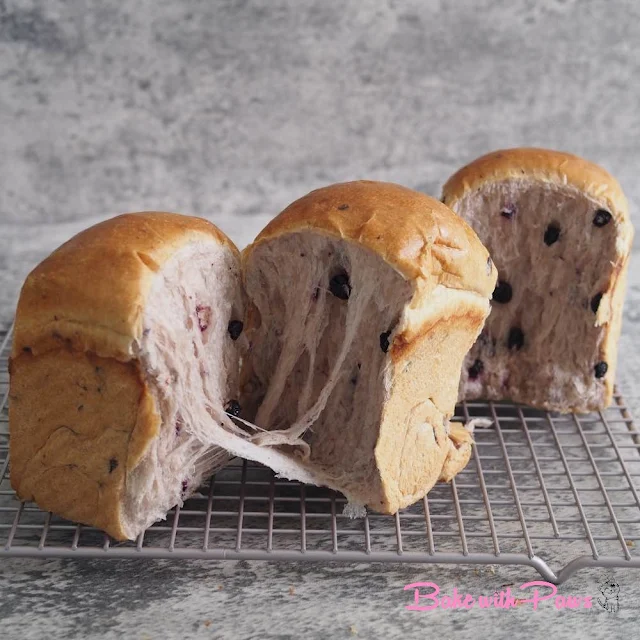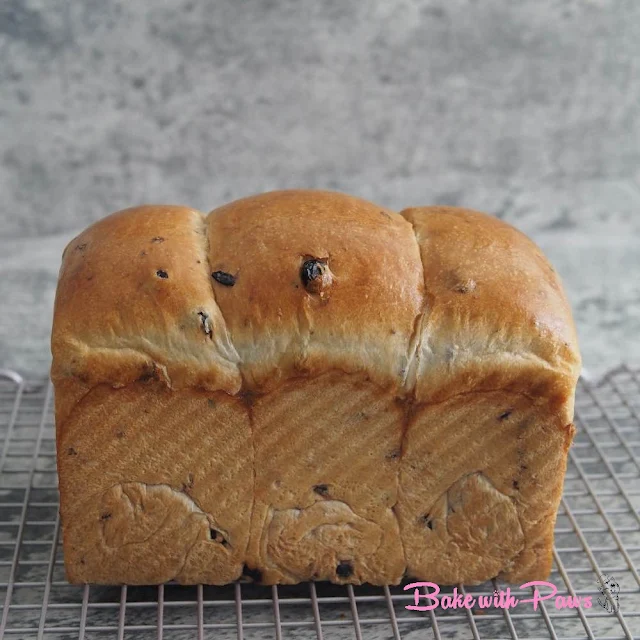Breads (Sourdough) - Soft Loaves
Blueberry Soft Sourdough Bread
February 03, 2023
| Recipe by Bake with Paws
Scroll to the bottom of the page for "PRINT RECIPE" ⬇
This Blueberry Soft Sourdough Bread turned out as what I like and I am happy with it. The bread is soft and fluffy with a texture that is quite similar to brioche. It is lasts well too.
Please bear in mind that blueberry has very little flavour and aroma in the bread unless added vanilla paste or extract.
If you have any questions regarding this recipe or any other post, please leave me a comment in the “LEAVE A COMMENT” link and I will reply you as soon as possible. Do tag me on Instagram @Bakewithpaws if you attempt on this recipe.
How To Make Bluberry Soft Sourdough Bread
Yields: 1 loaf
INGREDIENTS:
Sweet Stiff Starter:
56g sourdough starter (100% Hydration), use at its peak to get better result.
172g bread flour (I used Japan High Gluten Flour)
72g water
28g sugar (I used organic light brown sugar)
Main Dough:
130g bread flour (I used Japan High Gluten Flour)
All stiff starter (above)
15g light brown sugar (I used organic brown sugar), please add more sugar if you prefer sweet bread
1 tsp salt (5.7g)
45g cold egg, whisked (from 1 medium egg), balance use for egg wash
45g frozen blueberry (can be replaced with fresh blueberry)
45g milk, cold ((reserve 10g and add in later if needed) *
50g butter, room temperature
1 tsp vanilla extract or paste
45g dried blueberry, rinse with hot water and let them dry on a kitchen paper towel
Egg Wash: (Optional)
Balance of whisked egg from the above + 1/2 tsp water
Utensil:
450g loaf pan (21.3 X 12.2 X 11.5 cm / 8.4" X 4.8" X 4.5")
* Depends on your flour, because each flour absorbs liquid and hydrates differently. You may also add 1 teaspoon of milk at a time during kneading if the dough is too dry, when you see that the dough doesn't stick to the bottom at all. We want the dough to clear from the sides of the bowl with only a small part of the bottom sticking to the base of the mixer bowl. You should hear a slapping sound of the dough hitting the sides of the mixer bowl.
METHOD:
- Sweet Stiff Starter
- In a bowl of stand mixer, dilute starter with water, stir in sugar and add in bread flour. Mix with paddle attachment until well mixed and all come together. It can be done by hand mixing too.
- Cover and let it ferment until tripled. I prepared a night before and leave it in aircond room (approximately 24 - 25C room temperature) overnight until tripled. It took about 8 - 9 hours depending on your starter. It should take around 4 - 6 hours to get triple at room temperature at 28C - 30C.
- You can choose to ferment the starter in a jar or in the mixing bowl. Keeping it in the bowl makes it simpler to take out later, though you'll have to judge its size visually once it peaks.
- Main Dough:
- Put all ingredients (except butter and dried blueberry) into a bowl of stand mixer. I usually torn the stiff starter first.
- Slightly combine the mixture by hand with the paddle attachment before turning on the machine so that the flour will not splash out. Using the paddle attachment, mix at low speed #2 for about a minute or until all incorporated. This step is critical to prevent an uneven mixed dough as the stiff starter is rather hard and a dough hook may not be able to mix it well enough.
- Change to hook attachment and knead for another 3 minutes at low speed #2 (KA) or until the dough comes together. Add in butter and continue knead for 10 minutes at low speed #2 or until reach window pane stage. The whole kneading process, I stopped few times to scrape down the dough from the hook to be sure it is evenly kneaded and also to prevent the motor from overheating.
- Add in dried blueberry and continue kneading for about 1 -2 minute until the raisins evenly mix in the dough.
- 1st Proofing/Resting:
- In the same bowl, let the dough rest for 30 - 60 minutes. Keep it covered with clingfilm or use a lid. This dough I rested for 45 minutes at 29C - 30C room temperature and the dough rose slightly in 45 minutes.
- Shaping:
- Transfer the dough to a clean floured or slightly oiled surface then divide into 2 or 3 equal portions. Please use a kitchen scale if you want to be exact. This recipe is good for buns too.
- Form each portion to a ball. Flatten with rolling pin.
- Fold right to centre and fold left overlap it. Roll out with rolling pin into long rectangle shape. Roll up the dough like Swiss Roll until a small log is formed.
- Place all dough in the prepared loaf pan.
- Final Proofing :
- Let it proof in a warm place until the dough reaches about 1 cm below the height of the pan. This one took approximately 3 hours at room temperature of 29C - 30C. The duration of proofing depends on your ambient temperature and starter.
- Baking:
- Preheat oven at 180C - 200C (top & bottom heat) for 15 minutes.
- Brush with egg wash (optional) and bake in a preheated oven for about 30 - 35 minutes, or until golden brown.
- Remove bread from oven and let them cool on rack completely before slicing.
Sweet Stiff Starter
Main Dough
GENERAL NOTES:
SOURDOUGH STARTER
Please click this link for "How To Make Sourdough Starter" and "Sourdough Maintenance"
A healthy starter is very crucial as advised by Baking with Gina. It is advisable to feed your starter regularly if you want your bread to rise nicely and to use the starter (levain) at its peak. A starter that is fed regularly will be more active in general. If the mother starter is not strong, the bread dough will not rise a lot even though the starter is used at its peak.
GLUTEN DEVELOPMENT & WINDOWPANE TEST
Gluten forms when flour comes in contact with water. Hydration of the flour causes the sticky and stretchy protein to form, giving structure to the bread. This makes your bread trap air and rise.
Gluten in dough can be developed by autolyse, resting, kneading or folding.
The windowpane test is used to determine whether the dough has been sufficiently kneaded. By gently pulling the dough (or you may pinch off some dough) and trying to stretch it into a thin membrane. If you are able to stretch the dough paper thin and translucent without tearing, then the gluten is fully developed. However, if you can stretch it without tearing but the membrane is not transparent, then the gluten is not yet fully developed.
However, from my experience not all the recipe can achieve a thin and translucent window pane stage easily. For example low hydration and low fat dough. For such recipes, a reasonable window pane is good enough and it can be left to rest. Gluten will continue to develop while resting. Exercising restraint to not over-knead the dough prevents the gluten from being overworked and broken. Some of you may have experienced the dough breaking during the second proofing. It is because the dough is over kneaded.
The total kneading time for me is usually 15 minutes at low speeds except brioche dough with high fat percentage or dough using liquid fat which usually takes a little longer (maybe 18-20 mins).
From my experience, I found that high hydration dough with high percentage of fat will be easy to stretch and achieve a paper thin windowpane stage.
KNEADING TIME
For kneading, please regard the timing provided as an indication only. It is only meant as a guide. Timing may differ depending on the brand of flour and electric mixer used. The protein content may vary from one brand of flour to another.
FLOUR
The right flour plays a very important role in bread making. To achieve fluffy, soft and light bread, I used Japan High Gluten Flour in most of my bread baking. The protein content is around 12 - 13%.
HYDRATION
The liquid measurement given is also a guide. It is advisable to always reserve some liquid and not add it all in one go. This would give you the opportunity to adjust if necessary. If dough is too dry, add the reserve liquid one tablespoon at a time until the right consistency. This is because each flour absorbs water and hydrates differently.
PROOFING
Please note that the proofing timing may also vary depending on your climate, environment, flour and your starter.
If you are unable to judge by just looking at the dough, you can do the finger poke test:
- Lightly press the side of the proved dough with your finger. If it bounces back immediately without any indentation, it means the dough is under proved and needs more time before baking.
- If the indentation stays and it doesn’t bounce back, it means it has been over proved.
- If the indentation slowly bounces back and leave a small indentation, it is ready to bake.
- There will be a final burst of rising once the bread is placed to bake in the oven and it is called oven spring.
If your bread collapses or gets wrinkled on top after removing from oven, it could be because your dough over proved during the second proofing. Please proof until the tip of the dough just reaches the rim of the pan, around 80% - 90% in size.
BAKING TEMPERATURE AND TIME
Do also note that the baking temperature and timing provided are what works for my oven and should also be regarded as a guide only. Every oven behaves a little differently, so please adjust accordingly for your oven.
Labels:
Breads (Sourdough) - Soft Loaves,








Can i use discard for this recipe?
ReplyDeleteThanks for interest in this recipe. I normally don't encourage using sourdough discard to build sweet stiff starter unless your discard is very healthy and active.
DeleteCheers :)
Thank's so much
ReplyDeleteThanks for sharing such a beautiful recipe. I see in your ingredients list that there is 45g frozen blueberries and another 45g dried blueberries. In your method, only the dried ones were used. Is this a duplicate? Can I still use fresh berries?
ReplyDeleteThank you for sharing such a beautiful recipe. Your ingredients list has 45g of frozen blueberries as well as 45g dried blueberries but only one is used in the method. Please clarify.
ReplyDeleteHi, You are most welcome. Thank you for the clarification.
DeletePlease refer to:
2. Method.
1.Put all ingredients (except butter and dried blueberry) into a bowl of stand mixer.
All ingredients mean including the frozen blueberry.
I hope the above is clear.
Clear and happy baking:)
it’s still soft n taste good . But When pull the baked loaf apart mine is like with lots of tiny holes (mini crumb shot) and not long layer strand? What went wrong ?
ReplyDeleteHi, thank you for trying and your feedback. It could be the flour you used. Some flours do not produce with good gluten. Did you knead till you get the thin window pane like mine?
DeleteWhen not enough gluten form the texture will be crumbly instead of long strand.
Cheers :)